Enter Facebook Password scam (Free Instructions) - Removal Guide
Enter Facebook Password scam Removal Guide
What is Enter Facebook Password scam?
Enter Facebook Password scam — a fake message displayed by an adware
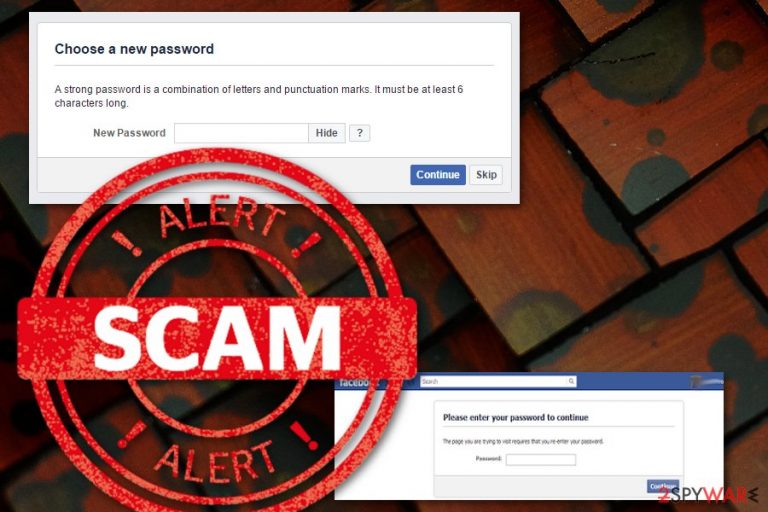
Enter Facebook Password scam is nothing more but adware that displays fake system alerts to steal user's login details. These pop-up[1] windows look identical to the legitimate Facebook website, but this “ Security Warning” is fake. Cybercriminals use this phishing[2] message to target Mac OS users. People enter their password and login information, but the second they do this, information gets on a criminals' remote server. Users are unaware of this activity and have no idea that cybercriminals collect this information and misused for money extortion or even identity theft.
| Name | Enter Facebook Password scam |
|---|---|
| Type | Adware |
| Danger level | High. Collects passwords and logins |
| Distribution | Intrusive ads, insecure software installations |
| Symptoms | Fake Facebook password entering messages, redirects, ads |
| Removal | FortectIntego is best for Enter Facebook Password scam removal |
Redirects to the scam site are triggered by adware program. Apart from this activity, you might also notice other symptoms of the potentially unwanted program (PUP). For instance, advertisements containing coupons, deals, and sales may appear all over your screen, but this is not the only symptom of adware. Ad-supported programs usually flood browser with questionable content and offer to install fake updates or bogus security software.
However, the main purpose of the Enter Facebook Password is to get user's login details. However, it's unknown how these details might be used in the future. There's no doubt that such activity might lead to various privacy-related issues. Thus, it's important to recognize the scam and do not fall for the criminals' tricks.
Scam creators trick people into giving access to their Facebook account by displaying these secure looking messages. Cybercriminals later send deceptive DMs to victims’ contacts asking for money, and this way tricks more people into this scam and earns a profit. This is dangerous because criminals use your identity. You could remove Enter Facebook Password simply by clicking window close button (X), but this is only the first step.
Later on, you should do proper adware eliminating. This can be done using anti-malware tools for Enter Facebook Password scam removal and full system scan. Those deceptive messages and redirects to various sites appearing on your device because you have active adware on your Mac. Only removing all potential threats can ensure you that the system is safe again. You can rely on FortectIntego for the full system clean.
After adware removal, you should immediately change your password if you got fooled in this scam so you can regain your access to your account and prevent anything harmful happening. Changing email or other account passwords are also recommended. 
Redirects to scam website begin after adware infiltration
Unwanted adware comes to your system without your consent. However, its installation requires your participation. PUPs usually spread bundled with freeware and enter the system when you do not pay attention to the installation procedure. When you skip through installation steps, you get these programs silently. Losvirus.es[3] team recommends you to be careful when downloading essential software and tools:
- Use reputable download sources;
- Read Privacy Policy and Terms of Use;
- Use Custom/Advanced settings;
- Opt out third-party programs that are offered to install along the primary software.
Proper Enter Facebook Password scam elimination
To remove Enter Facebook Password scam, you should use trustful anti-malware tools. The ad-supported application often has numerous components and hide deep in the system. So, it might be hard to locate and delete them all. However, if you feel skilled enough to do it yourself, have a look at our prepared guide below.
After Enter Facebook Password scam removal, you should change all your passwords. This task is especially recommended if you were tricked by the pop-up and revealed your credentials to crooks. However, you should also check your Facebook settings and disconnect from all unauthorized apps. We also suggest setting new and strong passwords for all your accounts.
You may remove virus damage with a help of FortectIntego. SpyHunter 5Combo Cleaner and Malwarebytes are recommended to detect potentially unwanted programs and viruses with all their files and registry entries that are related to them.
Getting rid of Enter Facebook Password scam. Follow these steps
Uninstall from Windows
Instructions for Windows 10/8 machines:
- Enter Control Panel into Windows search box and hit Enter or click on the search result.
- Under Programs, select Uninstall a program.
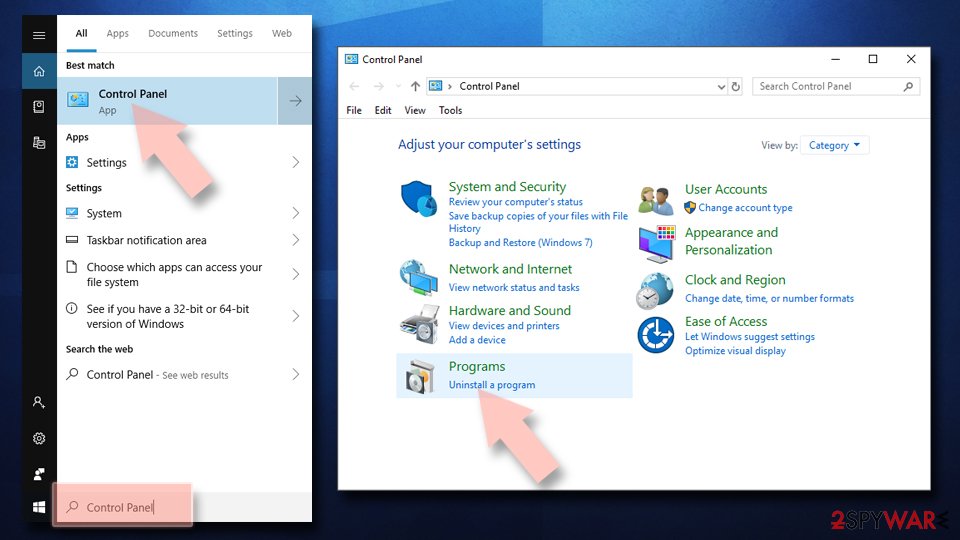
- From the list, find the entry of the suspicious program.
- Right-click on the application and select Uninstall.
- If User Account Control shows up, click Yes.
- Wait till uninstallation process is complete and click OK.
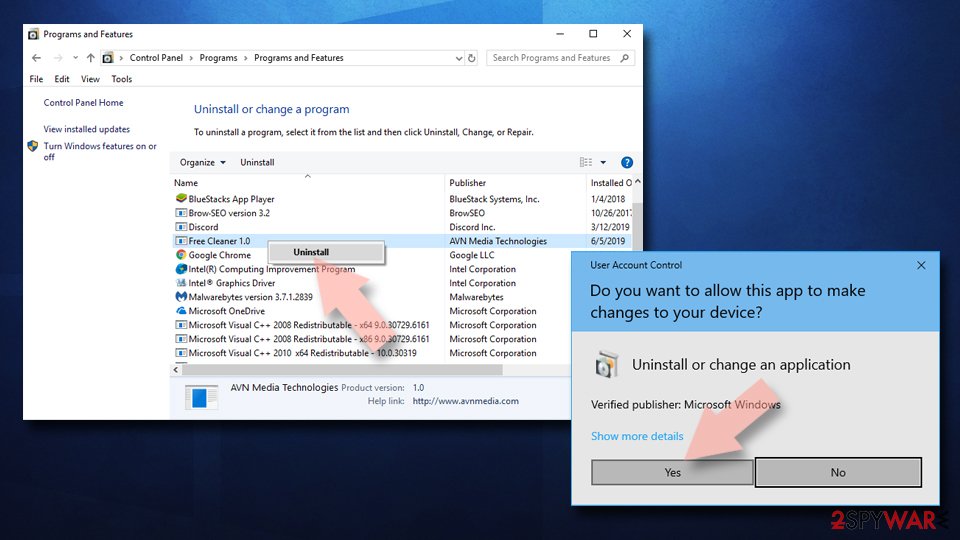
If you are Windows 7/XP user, proceed with the following instructions:
- Click on Windows Start > Control Panel located on the right pane (if you are Windows XP user, click on Add/Remove Programs).
- In Control Panel, select Programs > Uninstall a program.

- Pick the unwanted application by clicking on it once.
- At the top, click Uninstall/Change.
- In the confirmation prompt, pick Yes.
- Click OK once the removal process is finished.
Delete from macOS
Eliminate Enter Facebook Password scam from your system by following these steps:
Remove items from Applications folder:
- From the menu bar, select Go > Applications.
- In the Applications folder, look for all related entries.
- Click on the app and drag it to Trash (or right-click and pick Move to Trash)
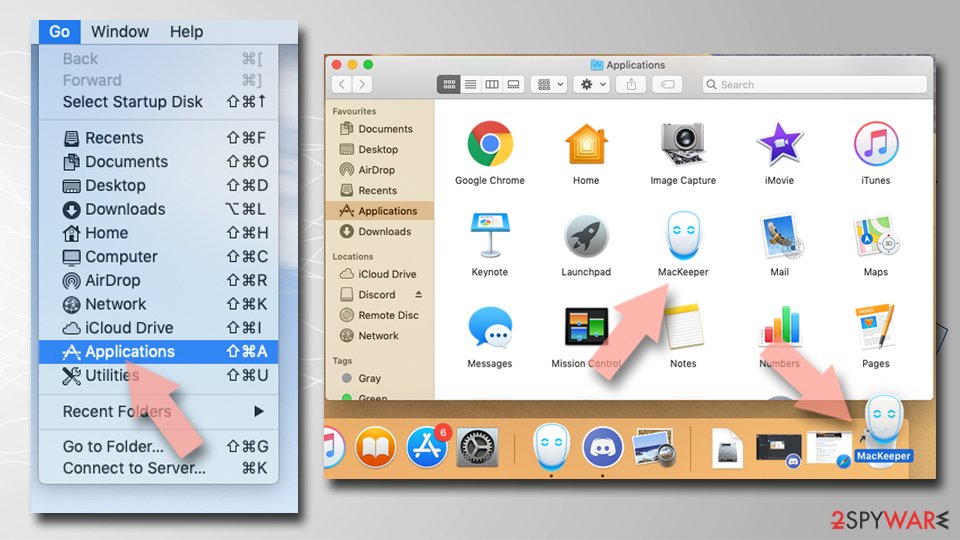
To fully remove an unwanted app, you need to access Application Support, LaunchAgents, and LaunchDaemons folders and delete relevant files:
- Select Go > Go to Folder.
- Enter /Library/Application Support and click Go or press Enter.
- In the Application Support folder, look for any dubious entries and then delete them.
- Now enter /Library/LaunchAgents and /Library/LaunchDaemons folders the same way and terminate all the related .plist files.

Remove from Microsoft Edge
Delete unwanted extensions from MS Edge:
- Select Menu (three horizontal dots at the top-right of the browser window) and pick Extensions.
- From the list, pick the extension and click on the Gear icon.
- Click on Uninstall at the bottom.
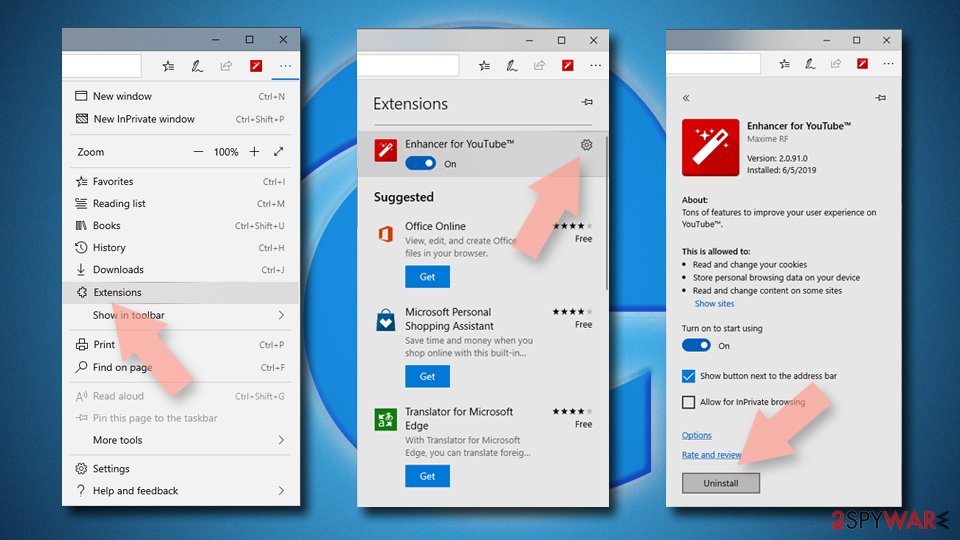
Clear cookies and other browser data:
- Click on the Menu (three horizontal dots at the top-right of the browser window) and select Privacy & security.
- Under Clear browsing data, pick Choose what to clear.
- Select everything (apart from passwords, although you might want to include Media licenses as well, if applicable) and click on Clear.
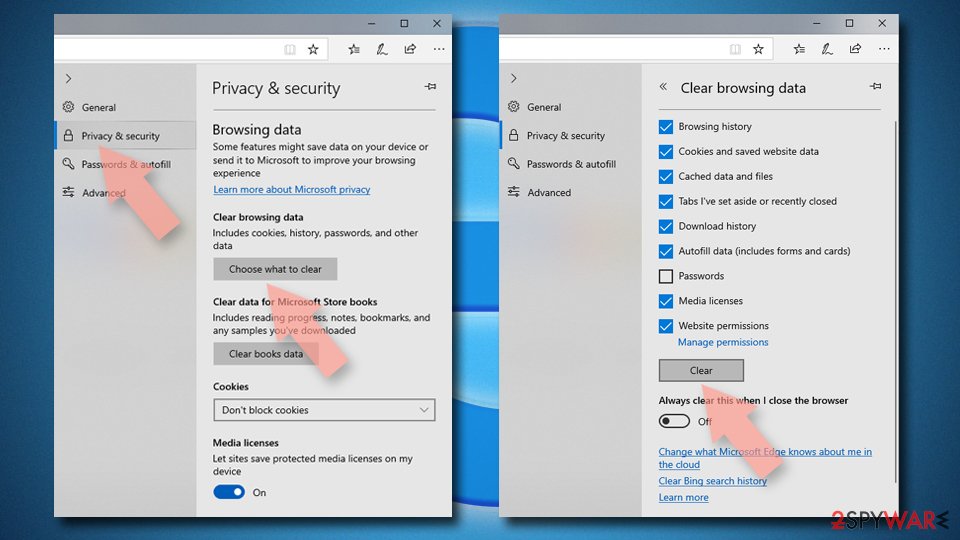
Restore new tab and homepage settings:
- Click the menu icon and choose Settings.
- Then find On startup section.
- Click Disable if you found any suspicious domain.
Reset MS Edge if the above steps did not work:
- Press on Ctrl + Shift + Esc to open Task Manager.
- Click on More details arrow at the bottom of the window.
- Select Details tab.
- Now scroll down and locate every entry with Microsoft Edge name in it. Right-click on each of them and select End Task to stop MS Edge from running.
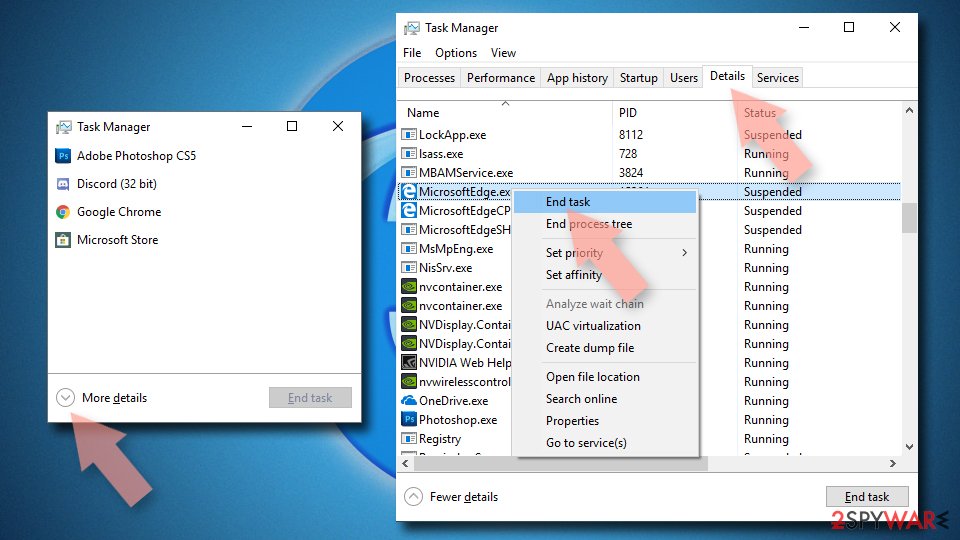
If this solution failed to help you, you need to use an advanced Edge reset method. Note that you need to backup your data before proceeding.
- Find the following folder on your computer: C:\\Users\\%username%\\AppData\\Local\\Packages\\Microsoft.MicrosoftEdge_8wekyb3d8bbwe.
- Press Ctrl + A on your keyboard to select all folders.
- Right-click on them and pick Delete
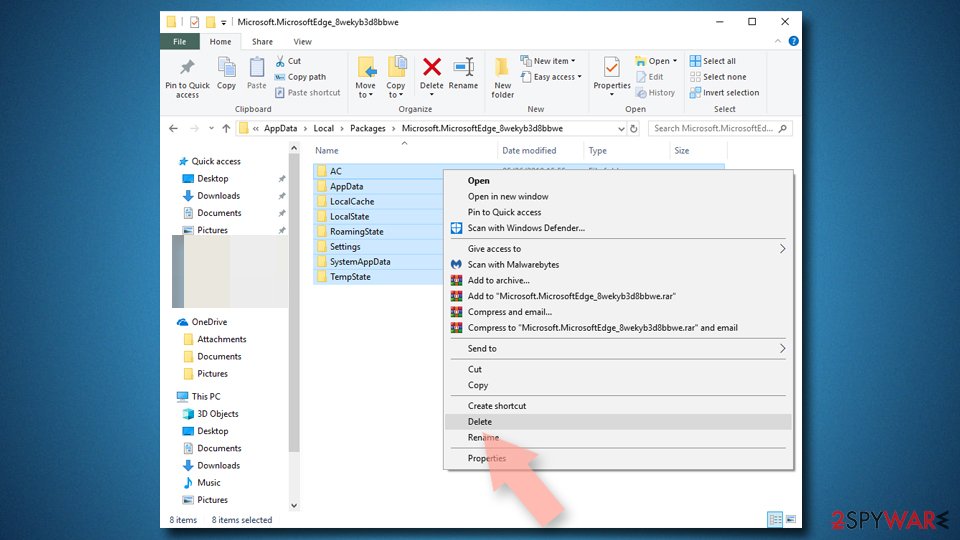
- Now right-click on the Start button and pick Windows PowerShell (Admin).
- When the new window opens, copy and paste the following command, and then press Enter:
Get-AppXPackage -AllUsers -Name Microsoft.MicrosoftEdge | Foreach {Add-AppxPackage -DisableDevelopmentMode -Register “$($_.InstallLocation)\\AppXManifest.xml” -Verbose
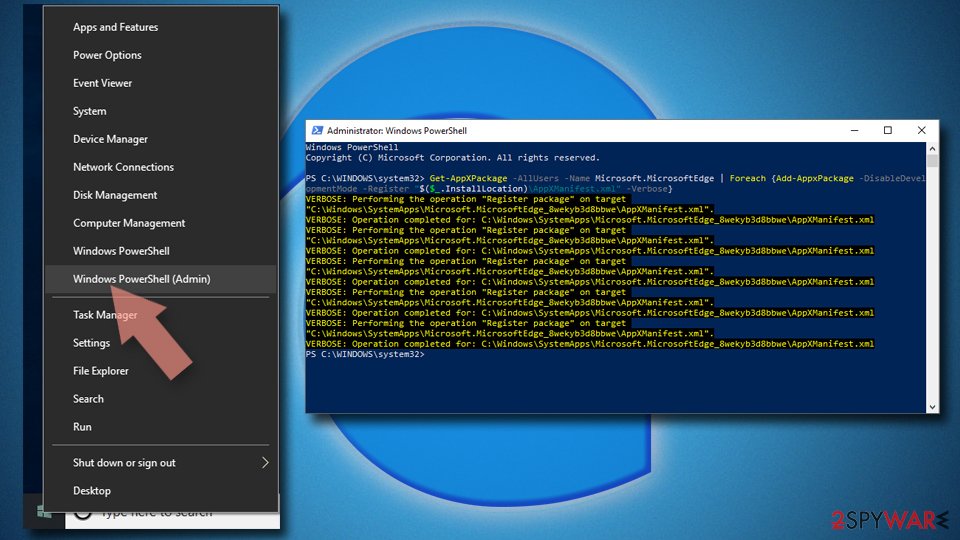
Instructions for Chromium-based Edge
Delete extensions from MS Edge (Chromium):
- Open Edge and click select Settings > Extensions.
- Delete unwanted extensions by clicking Remove.
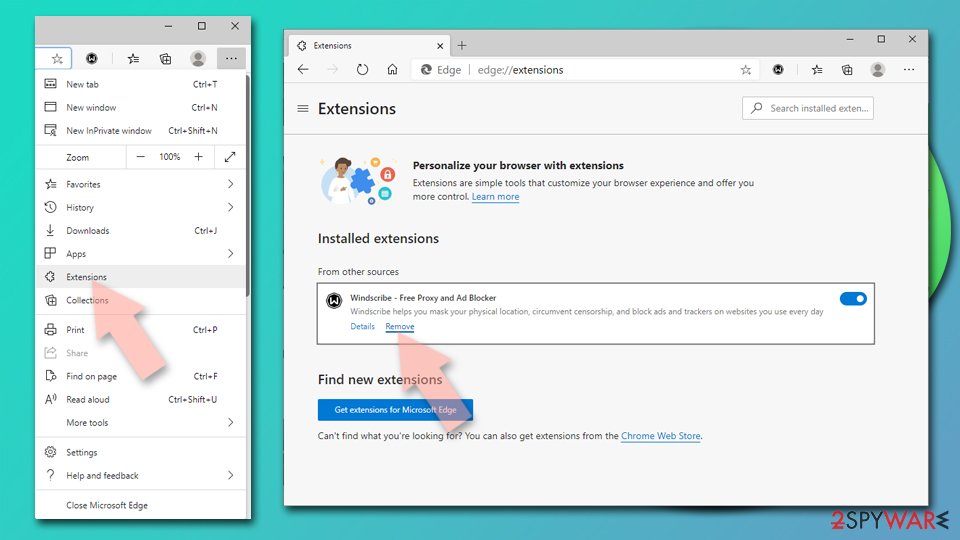
Clear cache and site data:
- Click on Menu and go to Settings.
- Select Privacy, search and services.
- Under Clear browsing data, pick Choose what to clear.
- Under Time range, pick All time.
- Select Clear now.
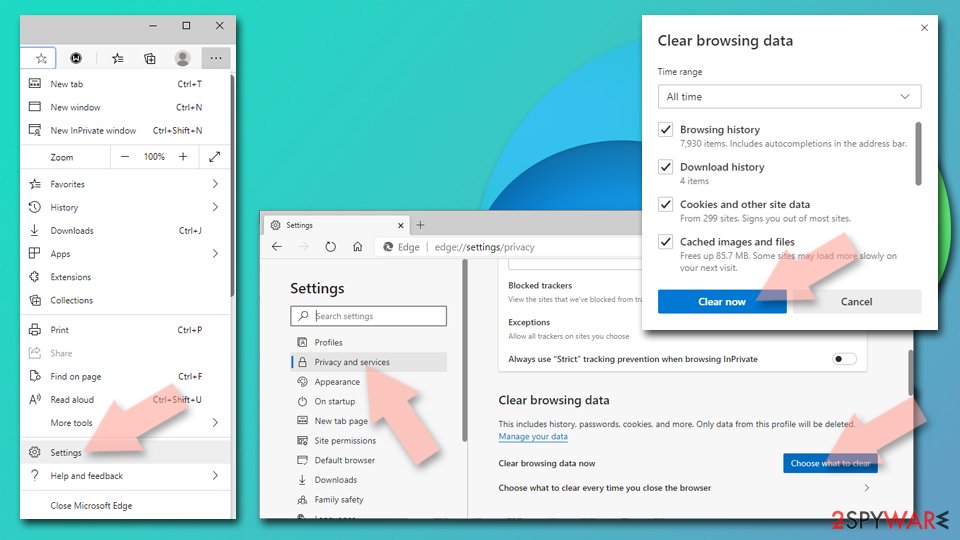
Reset Chromium-based MS Edge:
- Click on Menu and select Settings.
- On the left side, pick Reset settings.
- Select Restore settings to their default values.
- Confirm with Reset.
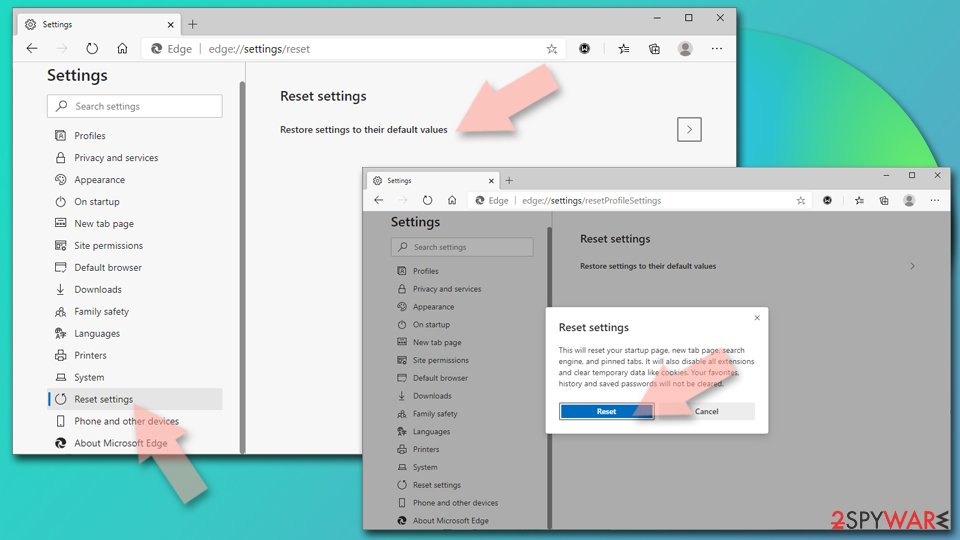
Remove from Mozilla Firefox (FF)
You can delete adware from Firefox using this guide:
Remove dangerous extensions:
- Open Mozilla Firefox browser and click on the Menu (three horizontal lines at the top-right of the window).
- Select Add-ons.
- In here, select unwanted plugin and click Remove.
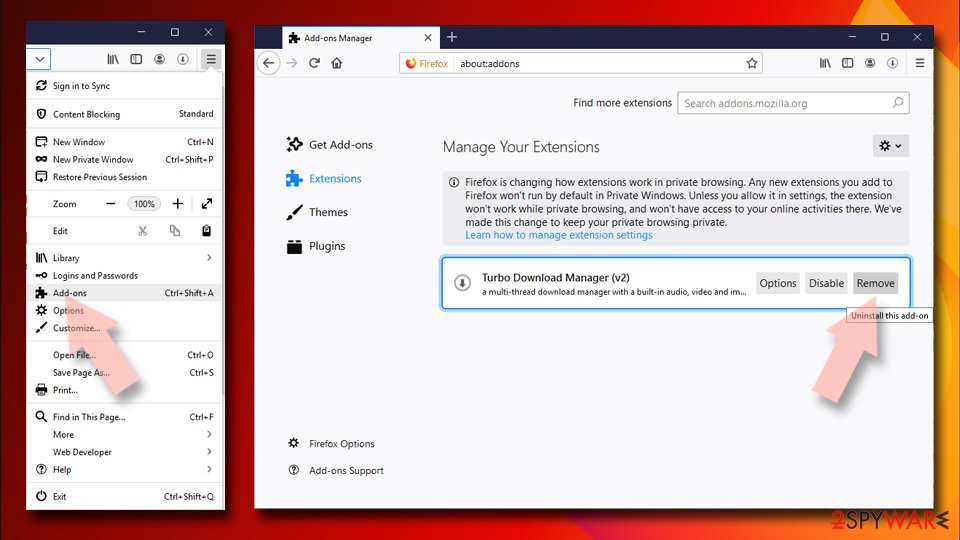
Reset the homepage:
- Click three horizontal lines at the top right corner to open the menu.
- Choose Options.
- Under Home options, enter your preferred site that will open every time you newly open the Mozilla Firefox.
Clear cookies and site data:
- Click Menu and pick Settings.
- Go to Privacy & Security section.
- Scroll down to locate Cookies and Site Data.
- Click on Clear Data…
- Select Cookies and Site Data, as well as Cached Web Content and press Clear.
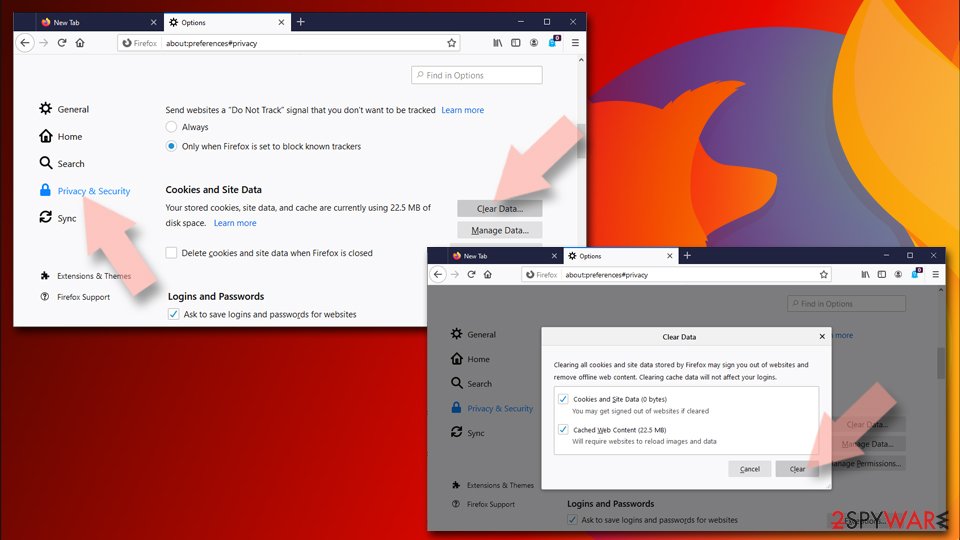
Reset Mozilla Firefox
If clearing the browser as explained above did not help, reset Mozilla Firefox:
- Open Mozilla Firefox browser and click the Menu.
- Go to Help and then choose Troubleshooting Information.
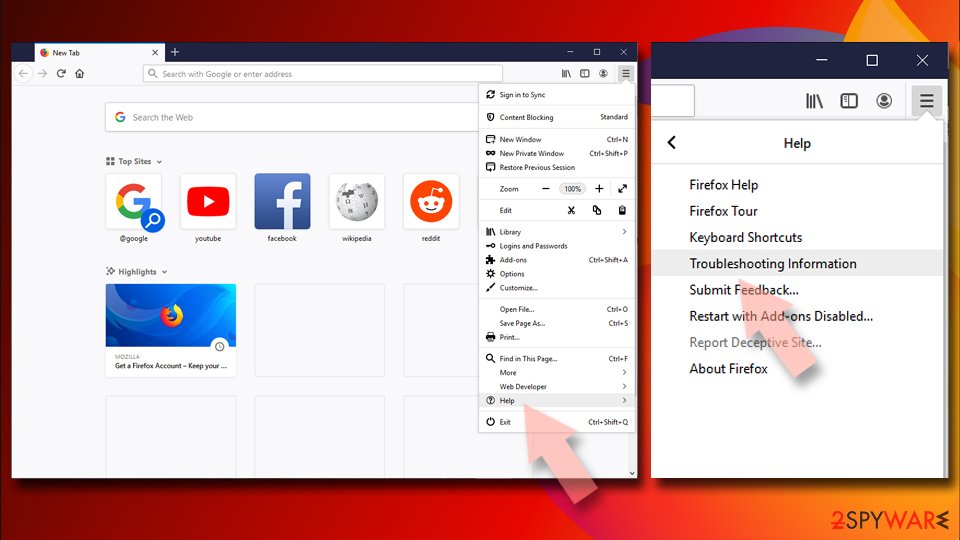
- Under Give Firefox a tune up section, click on Refresh Firefox…
- Once the pop-up shows up, confirm the action by pressing on Refresh Firefox.
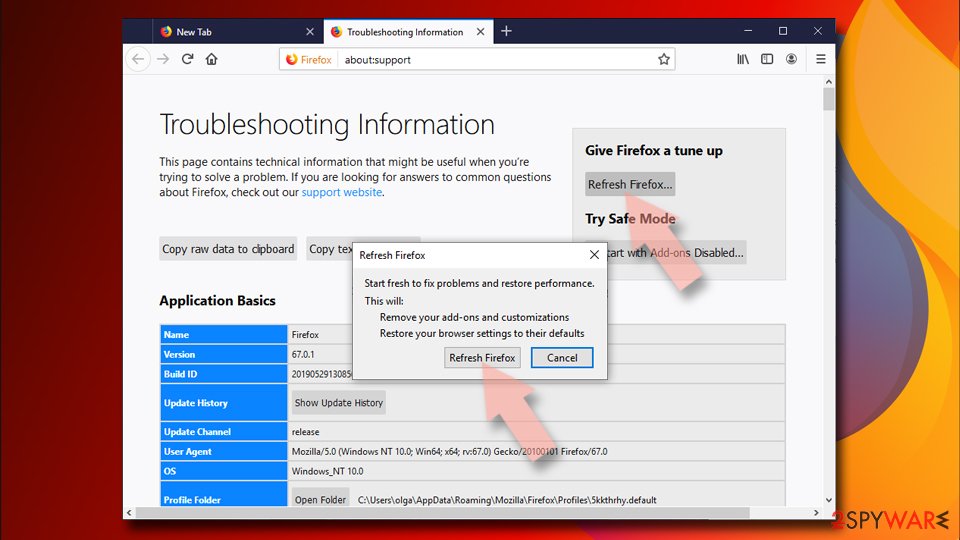
Remove from Google Chrome
Enter Facebook Password scam removal guide:
Delete malicious extensions from Google Chrome:
- Open Google Chrome, click on the Menu (three vertical dots at the top-right corner) and select More tools > Extensions.
- In the newly opened window, you will see all the installed extensions. Uninstall all the suspicious plugins that might be related to the unwanted program by clicking Remove.
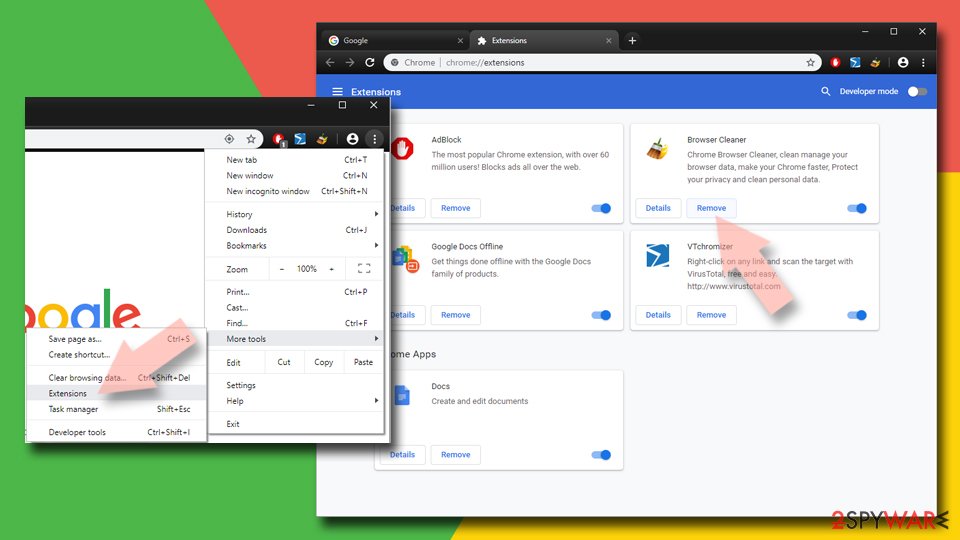
Clear cache and web data from Chrome:
- Click on Menu and pick Settings.
- Under Privacy and security, select Clear browsing data.
- Select Browsing history, Cookies and other site data, as well as Cached images and files.
- Click Clear data.
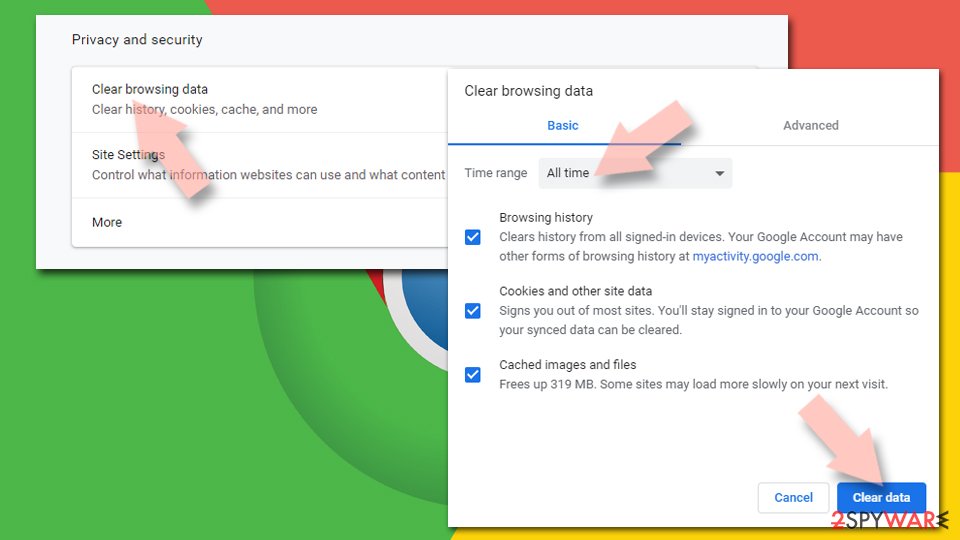
Change your homepage:
- Click menu and choose Settings.
- Look for a suspicious site in the On startup section.
- Click on Open a specific or set of pages and click on three dots to find the Remove option.
Reset Google Chrome:
If the previous methods did not help you, reset Google Chrome to eliminate all the unwanted components:
- Click on Menu and select Settings.
- In the Settings, scroll down and click Advanced.
- Scroll down and locate Reset and clean up section.
- Now click Restore settings to their original defaults.
- Confirm with Reset settings.
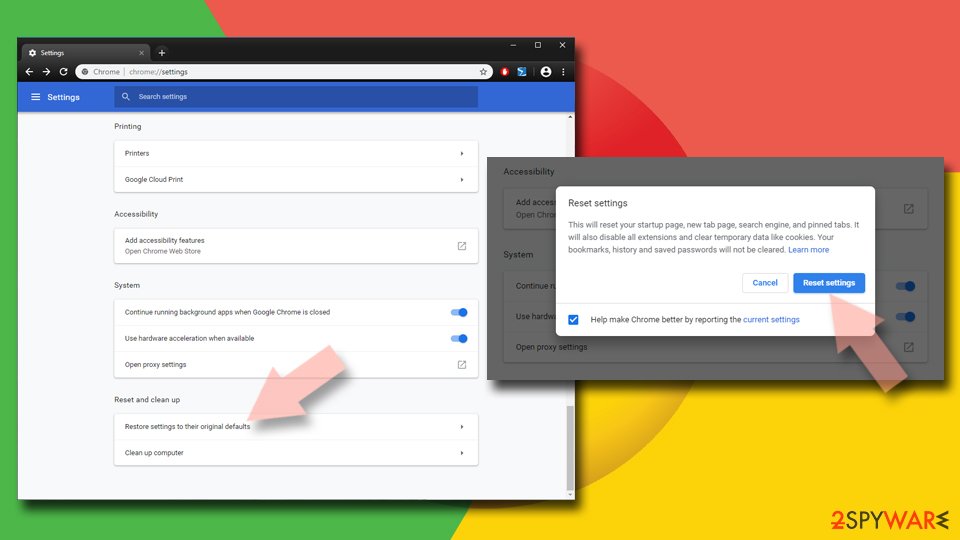
Delete from Safari
Get rid of this scam from the Safari browser:
Remove unwanted extensions from Safari:
- Click Safari > Preferences…
- In the new window, pick Extensions.
- Select the unwanted extension and select Uninstall.
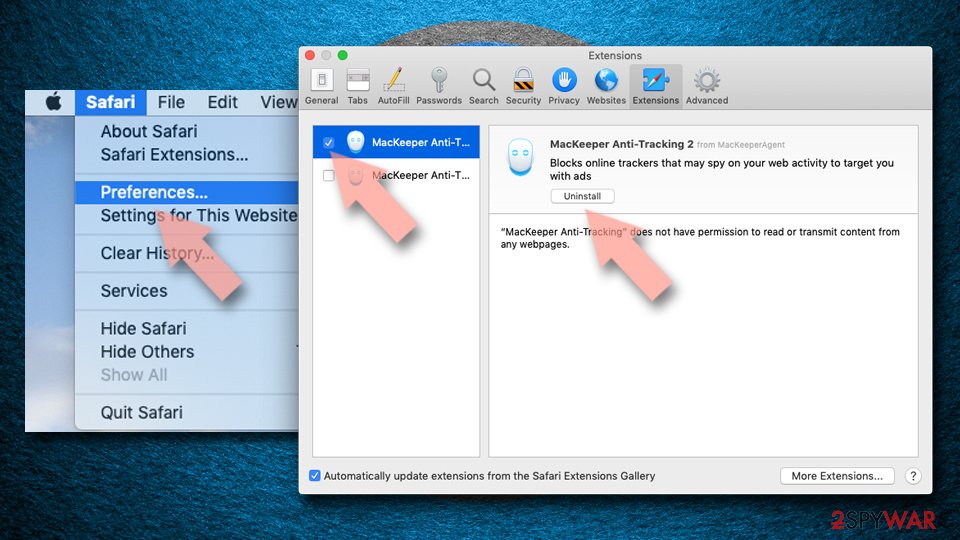
Clear cookies and other website data from Safari:
- Click Safari > Clear History…
- From the drop-down menu under Clear, pick all history.
- Confirm with Clear History.
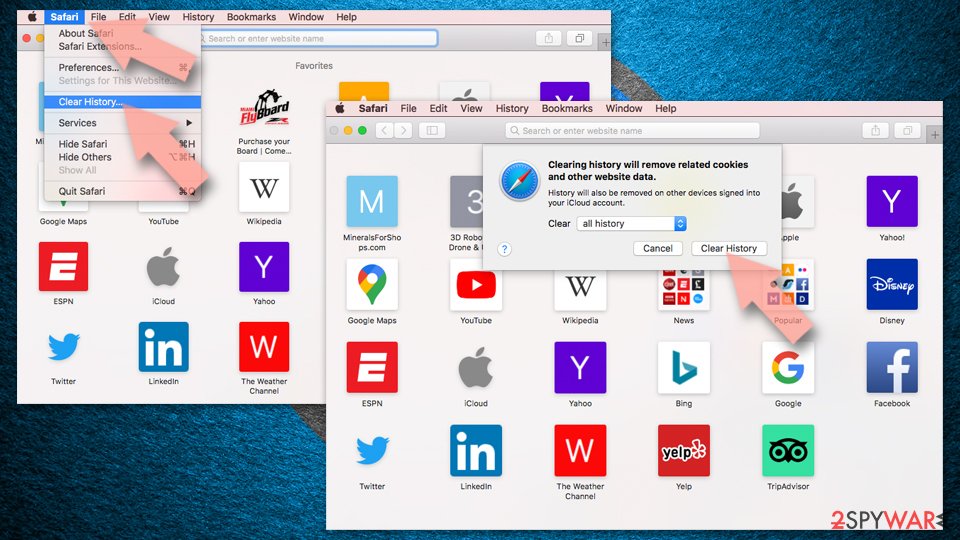
Reset Safari if the above-mentioned steps did not help you:
- Click Safari > Preferences…
- Go to Advanced tab.
- Tick the Show Develop menu in menu bar.
- From the menu bar, click Develop, and then select Empty Caches.
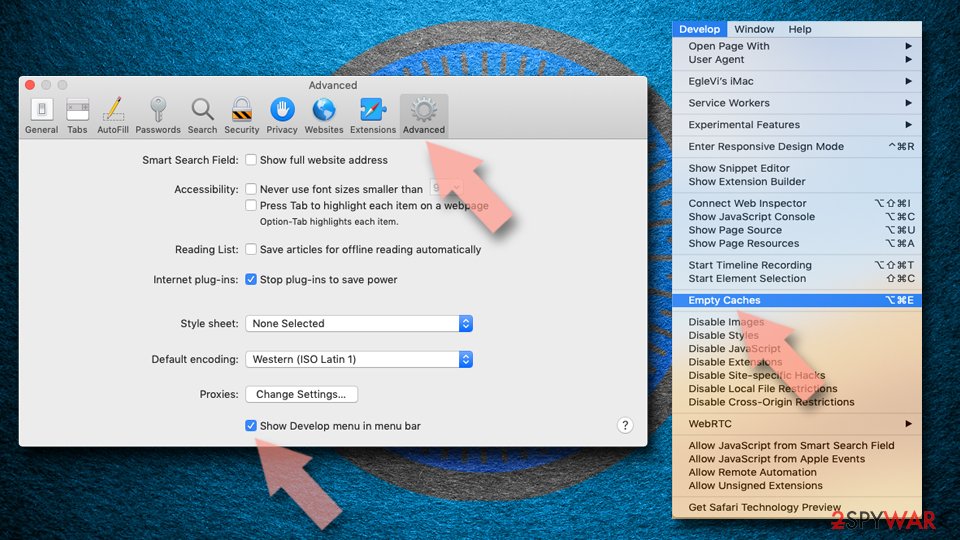
After uninstalling this potentially unwanted program (PUP) and fixing each of your web browsers, we recommend you to scan your PC system with a reputable anti-spyware. This will help you to get rid of Enter Facebook Password scam registry traces and will also identify related parasites or possible malware infections on your computer. For that you can use our top-rated malware remover: FortectIntego, SpyHunter 5Combo Cleaner or Malwarebytes.
How to prevent from getting adware
Choose a proper web browser and improve your safety with a VPN tool
Online spying has got momentum in recent years and people are getting more and more interested in how to protect their privacy online. One of the basic means to add a layer of security – choose the most private and secure web browser. Although web browsers can't grant full privacy protection and security, some of them are much better at sandboxing, HTTPS upgrading, active content blocking, tracking blocking, phishing protection, and similar privacy-oriented features. However, if you want true anonymity, we suggest you employ a powerful Private Internet Access VPN – it can encrypt all the traffic that comes and goes out of your computer, preventing tracking completely.
Lost your files? Use data recovery software
While some files located on any computer are replaceable or useless, others can be extremely valuable. Family photos, work documents, school projects – these are types of files that we don't want to lose. Unfortunately, there are many ways how unexpected data loss can occur: power cuts, Blue Screen of Death errors, hardware failures, crypto-malware attack, or even accidental deletion.
To ensure that all the files remain intact, you should prepare regular data backups. You can choose cloud-based or physical copies you could restore from later in case of a disaster. If your backups were lost as well or you never bothered to prepare any, Data Recovery Pro can be your only hope to retrieve your invaluable files.
